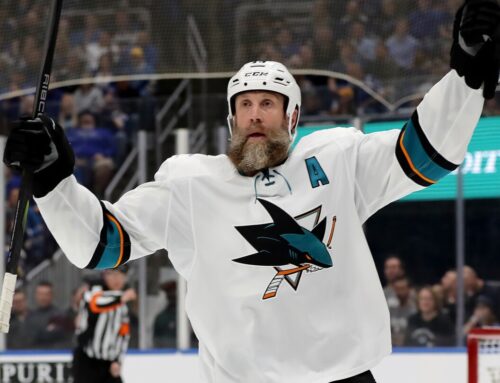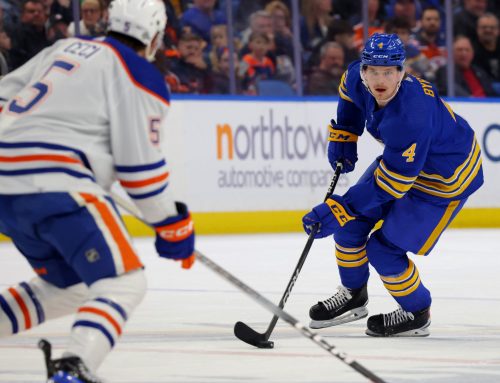
Capitals Take Series Lead, Guide To Power Forwards (June 3)
Despite leaving Game 2 with an upper-body injury, Evgeny Kuznetsov was back in the lineup for Game 3 of the Stanley Cup Final. The leading scorer of the playoffs scored a goal and added an assist in the Capitals’ 3-1 win over Vegas in Game 3, giving them a 2-1 series lead.
After a scoreless first period, Alex Ovechkin opened the scoring early in the second period on a backhand rebound after a mad scramble in front of the Vegas net. As you might expect, Ovie did it all in this game, taking five shots on goal and delivering two hits and blocking two shots.
Later in the second period, it was Kuznetsov’s turn, scoring on a 2-on-1. Kuznetsov leads all playoff scorers with 27 points, while his 12 goals places him third behind Mark Scheifele and Ovechkin in goals. At this point Kuznetsov should at least be in the Conn Smythe Trophy discussion.
Watch both of the Capitals’ second-period goals below.
Early in the third period, Tomas Nosek put Vegas on the board with his fourth goal of the playoffs after Braden Holtby mishandled the puck behind his net. After being practically absent from the scoresheet for most of the playoffs, Nosek scored his third goal of the Stanley Cup Final and fourth goal in his last five games. Fourth-liner Nosek is definitely your sleeper scorer in this series.
Later in the third period, Devante Smith-Pelly put it away for the Capitals with his fifth goal of the playoffs. Game 4 will be played on Monday in Washington.
So is the clock about to strike midnight for the rags-to-riches Golden Knights? It’s a bit early to say that, but some of the mojo that was working for them all season seems to be wearing off in this series. The Capitals continue to stifle teams defensively, as the run-and-gun Vegas team didn’t appear to be able to sustain pressure after initial scoring chances. At the very least, the Capitals are providing the expansion Golden Knights with their toughest test of the playoffs.
The scoresheet will show that Marc-Andre Fleury has allowed at least three goals in all three games of this series. Despite that, he made some impressive saves in Game 3, potentially keeping this game from getting out of hand.
He’s mostly an assists guy anyway, but David Perron has yet to score a goal in the Golden Knights’ playoff run. He’s actually taken fewer than one shot per game with just 12 shots in 14 games. The positive of his play is that he is tied for third on the team with eight assists.
Remember how I mentioned on Wednesday’s Ramblings that Jake Guentzel and Sidney Crosby were still tied for third in playoff scoring in spite of the Penguins being knocked out in the second round? Well, that’s still true. Of players still in the playoffs, Jonathan Marchessault, Reilly Smith, and Nicklas Backstrom (19 points each) are the most likely to catch the two Pens. For all his playoff exploits, Marchessault has been held without a goal in his past five games.
*
Looking for the fantasy skinny on Rasmus Dahlin? Eeli Tolvanen? Elias Pettersson? Any other prospects that you drafted for your keeper team or are thinking of drafting? You need Dobber’s 2018 Fantasy Hockey Prospects Report to stay ahead of your league’s competition. Buy it now! (Or after you read this edition of the Ramblings, of course…)
*
A carryover from my Mailbag earlier this week… and again, thank you for your submissions.
Maybe next time: Guide to Power Forwards (and D-men) … For leagues using PIMs players who can get points plus PIMs are so valuable , and seem to be getting rarer – some aging/underperforming (Byf, Simmonds …)
— Terry Cain (@tcain47) May 30, 2018
There were seven players that scored at least 35 points and accrued at least 75 penalty minutes this past season. Dustin Byfuglien was one of them, but Wayne Simmonds was not. The seven players that made that list were Tom Wilson, Byfuglien, Evgeni Malkin, Evander Kane, P.K. Subban, Ryan Johansen, and Mikael Backlund. Some of these names won’t be a surprise to you, while others will.
And yes, Terry, you’re right about true power forwards becoming more difficult to find. Many of the current crop are aging and may not be replaced while the NHL is becoming a speedier and less physical league. Byfuglien is 33 (remember, he was used as a forward at one time). Lucic will be turning 30 in a few days. Simmonds will be turning 30 this summer.
Below are four forwards of note. The first forward in the group is only 24 and may turn out to be a very rare type of player. By the way, I will continue this topic by covering physical defensemen in a future Ramblings.
If you weren’t familiar with Wilson’s shtick during the regular season, then you are now after watching the playoffs. It’s fair to say that he has earned more than enough attention for his over-the-edge play, but for some reason he needed more attention in fantasy leagues during the regular season, having been owned in just 41 percent of Yahoo leagues. Now that Wilson is a household name, watch that ownership percentage rise in 2018-19.
Simply put, if your league counts penalty minutes and/or hits, Wilson needs to be owned. Wilson finished second in the NHL with 187 penalty minutes and fourth with 250 hits. The question is, will Wilson continue to score enough to keep a spot on fantasy teams?
The fact that Wilson spent over 60 percent of minutes with Alex Ovechkin boosted Wilson’s value significantly, as this was a role he didn’t receive in the past. The fact that this arrangement has continued into the playoffs bodes well for Wilson’s future prospects. But if he is back on the third or fourth line, then he could be back to being a 25-point player. His lack of power-play time also limits his scoring upside.
Note: Micheal Haley was the league leader with 212 PIM. He scored just nine points all season, which doesn’t justify his existence in anything but the very deepest of fantasy leagues.
Malkin doesn’t seem like the type to earn a spot on this list, yet he has reached triple-digits in penalty minutes once in his career (2009-10), and he came awfully close to that with 87 penalty minutes in 2017-18.
In fact, there’s more there than you might think. Malkin has earned over a penalty minute per game played over his last three seasons, although he was held to just 57 and 62 games in the seasons prior to 2017-18. Over his career he has actually maintained that pace as well (784 GP, 813 PIM). So bump him up a few spots over the default rankings if your league counts penalty minutes.
If your league counts hits instead of penalty minutes, then you’ll simply want to target Malkin for his scoring. Malkin finished 17th on the Penguins with an unspectacular 48 hits all season. But hey, at least he delivers more hits than Phil Kessel.
Simmonds was once a must-own power forward in leagues that counted penalty minutes. You could count on him for at least 25 goals (which he has reached five times) and at least 100 penalty minutes (which he has also reached five times). But he reached neither mark in 2017-18, with his decline chronicled in a Geek of the Week article published in February.
So what happened? Simmonds missed seven games in 2017-18. Although that might not seem like a huge deal, it sticks out more when you notice that his points per game has declined for the second consecutive season (from 0.74 to 0.66 to 0.61). His plus-minus has also taken a hit over that span, as he has been a combined minus-35 over the past two seasons. In fact, Simmonds hasn’t been a plus player since 2009-10. Frequent line shuffling also often made Simmonds the odd man out, as he spent significant time on the third line.
If you’re programmed to draft Simmonds as a top-100 player because of his history as a power forward, you’ll want to break the habit for your next draft. Having said that, he could provide solid value outside the top 100 if he can bounce back in one or more of those categories.
If we’re talking power forwards, we also need to mention Lucic, since he finished second with 254 hits. You can count on him for hits, as he has been credited for at least 200 hits in each of his last six full seasons (dating back to his Boston days).
Over that six-season stretch, Lucic has also taken at least 75 minutes in penalties in five of those seasons. Prior to that Lucic reached the 100 PIM mark three times, so although he is a consistent penalty minute option, he has toned it down to a degree.
Where the concern lies now with Lucic is in points. Although he was a fixture on the Oilers’ first-unit power play featuring Connor McDavid, Lucic only scored seven power-play points, a major factor in what was an overall disappointing season for his scoring (just 10 goals and 34 points). Lucic was brought in to be the physical winger that would create space for McDavid without being a scoring liability. Yet his 25 PPP from his first season in Edmonton appears to be more of an outlier when it comes to his career power-play production. Aside from that season (2016-17), Lucic has never scored more than 14 PPP in any one season.
So if your league counts penalty minutes and/or hits, you can leave a spot for Lucic. Otherwise, there are plenty of other options that you should consider before Lucic.
*
For more fantasy hockey information, you can follow me on Twitter @Ian_Gooding.





 UTA
UTA PHI
PHI VGK
VGK EDM
EDM
 VAN
VAN L.A
L.A ANA
ANA NYI
NYI DAL
DAL
